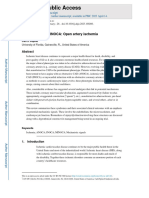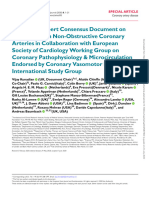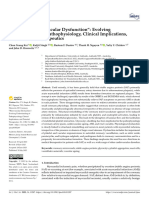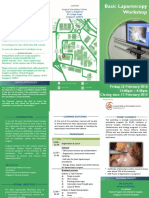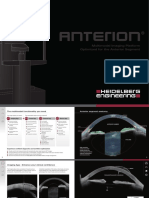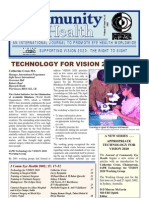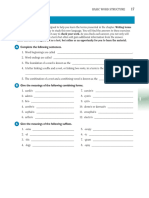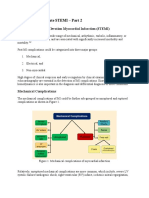Jurnal 2
Jurnal 2
Uploaded by
9z9ghsskyyCopyright:
Available Formats
Jurnal 2
Jurnal 2
Uploaded by
9z9ghsskyyCopyright
Available Formats
Share this document
Did you find this document useful?
Is this content inappropriate?
Copyright:
Available Formats
Jurnal 2
Jurnal 2
Uploaded by
9z9ghsskyyCopyright:
Available Formats
Review Cardiovascular Disease
Vasospastic Angina: A Contemporary
Review of its Pathophysiology, Diagnosis
and Management
Aish Sinha, Haseeb Rahman and Divaka Perera
The British Heart Foundation Centre of Excellence and the National Institute for Health and Care Research Biomedical Research Centre at
the School of Cardiovascular Medicine and Sciences, King’s College London, London, UK
N
early 40% of patients presenting to the catheter laboratory with angina have non-obstructed coronary arteries (ANOCA), an umbrella
term that encompasses distinct pathophysiological entities, such as coronary artery spasm. Coronary artery spasm leads to sudden
reversible coronary flow attenuation, which clinically manifests as vasospastic angina (VSA). VSA is associated with poor quality of
life and an increased risk of major adverse cardiac events. However, the pathophysiological mechanisms underlying this phenomenon are
incompletely understood, which has resulted in limited therapeutic options for patients afflicted with this condition. The past decade has
seen a surge in new research being conducted in the field of ANOCA and VSA. This review article provides a comprehensive summary of the
underlying pathophysiological mechanisms of VSA and the current therapeutic options. We also appraise the current diagnostic approach
in patients with suspected VSA.
Keywords Nearly half of patients who present with angina have non-obstructed coronary arteries
Angina with non-obstructed coronary (ANOCA).1 A significant proportion of these patients have a coronary vasomotor dysfunction,
arteries, coronary artery spasm, coronary such as coronary microvascular disease and/or coronary artery spasm.2,3 Vasospastic angina
physiology assessment, endothelial (VSA) refers to a dysfunctional state where there is sudden coronary flow attenuation as a result
dysfunction, vascular smooth muscle
of either epicardial or microvascular spasm, leading to downstream myocardial ischaemia and
hyperreactivity, vasospastic angina
angina. This phenomenon was first reported by Prinzmetal et al., who described it as a distinct
Disclosures: Aish Sinha, Haseeb Rahman and Divaka pathology that leads to resting chest tightness associated with marked ST-segment elevation
Perera have no financial or non-financial relationships
or activities to declare in relation to this article.
and a much greater prevalence of ventricular arrhythmias than classical effort angina.4 The
Review process: Double-blind peer review.
authors termed this entity ‘variant angina’ and hypothesized that it occurs due to a sudden
Compliance with ethics: This study involves a review of
and transient increase in vessel tone. Coronary artery spasm is now widely recognized as a
the literature and did not involve any studies with human distinct pathophysiological entity that can lead to myocardial ischaemia. In 2015, the Coronary
or animal subjects performed by any of the authors.
Vasomotion Disorders International Study (COVADIS) group proposed the international
Data availability: Data sharing is not applicable
to this article as no datasets were generated or
standardization of diagnostic criteria for VSA to harmonize clinical and research work on VSA.5
analyzed during the writing of this article. This allows ‘definitive VSA’ to be diagnosed either by coronary angiography with pharmacological
Authorship: The named authors meet the International stimulation and/or by ambulatory electrocardiogram (ECG) recording. Both of these approaches
Committee of Medical Journal Editors (ICMJE) criteria
for authorship of this manuscript, take responsibility
are recommended by the European Society of Cardiology and the Japanese Circulation Society
for the integrity of the work as a whole, and have when investigating patients with suspected VSA.6,7
given final approval for the version to be published.
Access: This article is freely accessible at
touchCARDIO.com. © Touch Medical Media 2022
VSA has been associated with poor quality of life and increased risk of adverse cardiovascular
Received: 4 April 2022 outcomes.8 However, its underlying pathophysiology remains incompletely defined, and
Accepted: 30 May 2022 the factors contributing to the development of VSA are poorly understood. The current
Published online: 26 July 2022 management of VSA focuses on mitigating cardiovascular risk factors and anti-anginal therapy,
Citation: Heart International. 2022;16(2):Online specifically calcium channel blockers (CCBs) and long-acting nitrates. The focus of this review
ahead of journal publication
article will be on the pathophysiology, diagnosis and contemporary management of patients
Corresponding author: Divaka Perera,
with VSA (Figure 1).
Department of Cardiology, St Thomas’ Hospital,
London SE1 7EH, UK. E: divaka.perera@kcl.ac.uk
Flow augmentation in the healthy vasculature
Support: No funding was received for
The coronary vasculature comprises epicardial arteries (>400 μm), pre-arterioles (100–400 μm),
the publication of this article.
arterioles (<100 μm) and capillaries (<10 μm).9 The epicardial arteries function as conduit vessels.
The arterioles regulate coronary vascular resistance and, therefore, coronary blood flow (CBF)
in response to changes in myocardial oxygen demand.9 The capillary bed delivers oxygen and
substrates to the myocytes.9 The endothelium plays an important role in the modulation of
vascular tone by synthesizing and releasing several vasodilator substances, such as nitric oxide
(NO).9 Increased endothelial wall shear stress and acetylcholine (ACh) are determinants of CBF
in health.9
TOUC H MED ICA L MEDIA Journal Publication Date: In Press 1
Review Cardiovascular Disease
Figure 1: Summary of vasospastic angina and its management
Vasopastic angina
Outcomes Diagnosis Management
Microvascular spasm Non-invasive
Ambulatory ECG monitoring CCBs
Epicardial spasm
Invasive Nitrates
Intracoronary acetylcholine
Obstructive CAD
Nicorandil
MINOCA presentation
Fasudil
neutral outcome negative outcomes positive therapeutic effect under investigation but not licensed
CAD = coronary artery disease; CCB = calcium channel blocker; ECG = electrocardiogram; MINOCA = myocardial infarction with non-obstructed coronary arteries.
The pathophysiology of vasospastic angina coronary endothelial dysfunction.18 This suggests that there may be an
Coronary endothelial dysfunction additional mechanism that, in the presence (or sometimes even in the
In the presence of functional endothelium, the balance of shear absence) of coronary endothelial dysfunction, leads to coronary artery
stress-induced vasodilation and vasoconstriction tips towards the former; spasm. VSM hyperreactivity may represent this additional mechanism
however, in the presence of endothelial dysfunction, the balance tips and is discussed below in detail.
towards the latter.10,11 Under normal physiological circumstances, shear
stress, by activating mechanoreceptors on endothelial cells, triggers Vascular smooth muscle hyperreactivity
the endothelial NO synthase (eNOS), in the presence of its cofactor Although the mechanisms leading to VSM hyperreactivity are not fully
tetrahydrobiopterin, to convert L-arginine into NO.11 However, certain understood, it is thought to be a manifestation of an alteration of the
conditions, such as a systemic inflammatory state, impair the ability of signal transduction pathway somewhere between, but not including,
eNOS to produce NO; this is known as ‘eNOS uncoupling’.11 Coronary the cellular receptors and the contractile proteins in the VSM cell.
endothelial dysfunction is thought to be a precursor of obstructive Porcine models of coronary spasm have demonstrated that the
coronary artery disease (CAD), and it is a marker of adverse cardiovascular calcium handling mechanism of contractile proteins remains unaltered,
outcomes.12 In the setting of coronary artery spasm, several clinical as does the expression of cellular receptors involved in promoting
studies have demonstrated reduced NO activity.13 Furthermore, the vasoconstriction.19,20 Animal studies have also implicated the protein
observation that animal models with mutations of the eNOS gene are kinase C-mediated pathway in the pathogenesis of coronary artery
predisposed to developing coronary artery spasm further supports the spasm.21 These results suggest that calcium (Ca2+) entry through L-type
contribution of coronary endothelial dysfunction in the pathogenesis Ca2+ channels into VSM cells is the initial trigger for coronary artery spasm
of coronary artery spasm.14 ACh is used as the preferred agent to test and that Ca2+ entry might be augmented via protein kinase C-dependent
coronary endothelial integrity in the catheter laboratory; this is because mechanisms. Indeed, it has been demonstrated that L-type Ca2+ channels
of its dual action on muscarinic receptors on the endothelium and are functionally upregulated at the spastic site in a porcine model of
vascular smooth muscle (VSM). coronary artery spasm.22 Animal studies have also reported that rho
kinase is upregulated at the spastic site and plays a key role in inducing
Dysfunctional endothelial cells release endothelin-1 (ET-1), which is VSM hypercontraction by inhibiting myosin light chain phosphatase.23
a potent vasoconstrictor. Several clinical studies have demonstrated Fasudil, a rho kinase inhibitor, has been shown to markedly attenuate
higher coronary sinus plasma ET-1 levels in patients with demonstrable ACh-induced coronary vasoconstriction in patients with coronary artery
coronary artery spasm during provocation assessment.15 Ford et spasm.24 It has been hypothesized that coronary endothelial dysfunction
al. reported an attenuated vasorelaxation in response to ACh and plays a greater role in diffuse multi-vessel spasm, whereas VSM
augmented vasoconstrictive response to ET-1 in gluteal biopsy samples hyperreactivity plays a greater role in focal spasm.
of patients with VSA compared with control subjects, indicating a state
of systemic endothelial dysfunction in these patients.16 Finally, in a Clinical presentation and outcomes
cohort of patients with ANOCA, Reriani et al. reported an improvement VSA should be suspected in patients with anginal symptoms occurring
in coronary endothelial function after treatment with an endothelin A predominantly at rest, especially if the resting symptoms follow a
receptor antagonist.17 diurnal pattern (being worse at night and in the early morning). Although
Prinzmetal’s reports had linked episodes of coronary vasospasm
However, whilst coronary endothelial dysfunction has been implicated predominantly with ST-segment elevation, there is now a greater
in the development of coronary artery spasm, it has been demonstrated appreciation that an episode of coronary artery spasm can present with
that not all vessels that are predisposed to spasm have underlying disparate ischaemic ECG changes commensurate with the degree of
2 HEART I NTE RNATIONA L
Vasospastic Angina: A Contemporary Review of its Pathophysiology, Diagnosis and Management
coronary flow attenuation.4 Prolonged and more occlusive episodes of Invasive coronary physiology assessment in the
coronary artery spasm have a greater propensity to lead to ventricular catheter laboratory
arrhythmias; this is thought to be due to an increased inhomogeneity Coronary vascular assessment with ACh stimulation can be performed
of ventricular depolarization and repolarization due to acute, severe readily and safely in patients with suspected VSA.35 It is recommended
and transient myocardial ischaemia.25 These factors increase ventricular that patients with ANOCA should undergo coronary physiology
vulnerability and heighten the risk of sudden cardiac death.26 assessment to detect coronary vascular dysfunction that can act as
a substrate for myocardial ischaemia. The main parameter used to
The major adverse cardiac events rate, a composite of death, non-fatal distinguish normal from abnormal coronary vascular function is the CFR.
myocardial infarction (MI), unstable angina and heart failure, has been CFR is the ratio of hyperaemic to baseline CBF in response to adenosine
reported to be around 5–6% over a median follow-up period of 3–4 and reflects the ability of the coronary vasculature to augment blood
years in patients with VSA.27,28 Two endotypes of coronary artery spasm flow in response to increased demand. An impaired CFR, defined as CFR
are recognized: epicardial spasm (arbitrarily defined as ≥90% epicardial <2.5, in the presence of a normal fractional flow reserve is suggestive
artery vasoconstriction in response to ACh stimulation, ischaemic ECG of endothelium-independent coronary microvascular disease; this is
changes and characteristic chest pain) and microvascular spasm (a associated with an increased likelihood of myocardial ischaemia on
diagnosis of exclusion, namely <90% epicardial artery vasoconstriction non-invasive assessment and adverse cardiovascular outcomes.34,36,37
in response to ACh stimulation, ischaemic ECG changes and
characteristic chest pain).5 A recent study reported a 7.5% incidence Intracoronary ACh infusion, at concentrations of up to 10-4 mol/L, can be
of all-cause mortality, 1.4% MI and 2.2% stroke over a median 7-year used to assess coronary endothelial function, with a normal response
follow-up in patients with invasively characterized coronary artery being an increase in CBF by 50% or more compared with the basal
spasm.8 Recurrent symptoms were reported in 64% of patients, and flow (i.e. an AChFR of >1.5).38 An AChFR of ≤1.5 has been associated
12% of patients underwent a repeat coronary angiography. Multivariate with myocardial ischaemia on non-invasive assessment and with an
analysis revealed epicardial spasm as a predictor of non-fatal MI and increased risk of adverse outcomes.12,38,39 In cases where the pre-test
repeat angiography, whereas patients with microvascular spasm more probability of coronary vasospasm is high, operators should carry out
often had recurrent angina at follow-up.8 Whilst the overall prognosis coronary spasm assessment using ACh bolus.34 There is variation in
of patients with ANOCA and coronary artery spasm is generally the doses and delivery rates of ACh used during spasm assessment,
favourable, patients with obstructive CAD who are predisposed to although the underlying scientific rationale remains the same. The
spasm have a worse outlook.29 Furthermore, patients with obstructive general consensus is to deliver a 100 µg bolus of ACh down the left
CAD who develop spasm within the stenotic segment are more likely anterior descending artery over 20 seconds; this dose needs to be halved
to suffer from adverse cardiovascular outcomes compared with those (i.e. 50 µg over 20 seconds) if being delivered into the right coronary artery
who develop spasm in the non-stenotic coronary segment or those due to the higher risk of bradyarrhythmias.34 Clinicians should remain
who do not develop spasm at all.30 The mechanisms underlying this vigilant and promptly manage ACh-induced tachyarrhythmias with
are unclear; however, animal studies have demonstrated that intimal pharmacological/electrical cardioversion and spasms with intracoronary
injury is prevalent in stenotic segments that develop spasm with nitroglycerin. A diagnosis of epicardial artery spasm is made when ACh
pharmacological stimulation.31 Therefore, it is conceivable that spasm bolus leads to ≥90% coronary vasoconstriction, ischaemic ECG changes
within a stenotic segment can cause plaque disruption and, therefore, and chest pain; this protocol and diagnostic threshold is associated with
predispose to acute coronary syndrome. Finally, patients with MI with a high degree of sensitivity and specificity for the detection of coronary
non-obstructed coronary arteries secondary to coronary vasospasm spasm in patients with VSA symptoms.5,40 The diagnosis of microvascular
have a heightened risk of all-cause mortality, cardiac death and spasm is made when ACh bolus leads to ischaemic ECG changes and
readmission with acute coronary syndrome.32,33 Coronary artery spasm chest pain in the absence of ≥90% coronary vasoconstriction; in the
provocation assessment was shown to be safe in patients presenting absence of significant epicardial spasm, an AChFR <1.0 with ACh bolus
with MI with non-obstructed coronary arteries, and it helps identify is also suggestive of microvascular spasm as it demonstrates flow
a high-risk patient cohort who may benefit from close follow-up and attenuation.5,34 An example of a vessel with significant epicardial spasm
aggressive pleiotropic and anti-ischaemic therapies.32,33 in response to ACh bolus is shown in Figure 2.
Diagnosis Diagnostic challenges
Non-invasive assessment of coronary vasospasm Whilst our suggested ACh protocol is the most commonly used one, other
According to the COVADIS criteria, if a spontaneous episode of rest derivations exist and are associated with varying degrees of sensitivity
angina is associated with transient ischaemic ECG changes, and if there and specificity.34 These include the incremental infusion of ACh at 0.86,
is no other cause identified for the ECG changes, then coronary artery 8.63, 86.3, 863 µg/mL over 3 minutes or incremental boluses of ACh at
spasm is presumed to be responsible, and a definitive diagnosis of VSA 100–200 µg over 20 seconds.7,41 These derivations have important
may be made without formal documentation of coronary artery spasm.5 clinical implications; for example, a 200 µg bolus is more likely to lead to
However, it is generally not feasible to document ischaemic ECG changes multivessel spasm than a 100 µg bolus, and a 20-second bolus is more
during spontaneous episodes of rest angina. Furthermore, coronary likely to lead to vasospasm than a 3-minute infusion of the same dose.42,43
artery spasm frequently co-exists with epicardial CAD and/or coronary Furthermore, it is not known what dose and infusion rate of ACh correlates
endothelium-independent dysfunction. Therefore, performing one with physiological degrees of spasm, the caveat being that, beyond a
procedure (i.e. coronary angiography with invasive coronary physiology certain threshold of dose and infusion rate, ACh may provoke spasm in
assessment) that allows for a comprehensive assessment of the entire any individual.44 This phenomenon was observed in a study investigating
coronary vascular function (fractional flow reserve, coronary flow reserve the effects of varying concentrations of ACh in patients with normal
[CFR], ACh flow reserve [AChFR] and spasm assessment) and provides epicardial arteries.45 The authors reported an increase in epicardial vessel
insights into the spasm endotype (epicardial versus microvascular spasm) diameter and CBF with ACh concentrations of up to 10-4 mol/L; however,
is now the investigation of choice in this patient cohort.34 significant vasoconstriction, accompanied by chest pain, was observed
HE ART IN TERN ATIO N A L 3
Review Cardiovascular Disease
Figure 2: Coronary angiography images of the left coronary artery at baseline (left) and after acetylcholine bolus (right) in a
patient with epicardial coronary artery vasospasm
IC ACh bolus
The yellow arrows demonstrate the diffuse segments of spasm in the left anterior descending artery.
IC Ach = intracoronary acetylcholine.
with concentrations of 10-3 mol/L.45 This led the authors to conclude Nicorandil
that the local ACh concentration and the coronary vascular segment Nicorandil leads to vasodilation via two mechanisms. Firstly, it
under question may play a significant role in the observed response stimulates soluble guanylate cyclase and leads to increased cyclic
to ACh.45 Finally, the diagnostic threshold for the degree of epicardial guanosine monophosphate concentrations. Secondly, it leads to
vasoconstriction in response to ACh can also vary between centres. The hyperpolarization by opening the adenosine triphosphate-sensitive
majority of centres use the 90% threshold; however, some centres use potassium channels; this subsequently leads to a closure of the
different arbitrarily chosen thresholds, such as 75% vasoconstriction.34,35 calcium channels. Nicorandil reduces anginal burden in patients with
Using different diagnostic thresholds will, of course, alter the diagnostic VSA.52 The Japanese Cardiology Society give a IIa recommendation
sensitivity and specificity. for the use of nicorandil in patients with VSA, although it remains the
second line in European guidelines.6,7
Therefore, although invasive coronary physiology assessment with
ACh stimulation remains the investigation of choice in patients with Rho kinase inhibitors
suspected VSA, it has certain caveats that clinicians should bear in Clinical studies have demonstrated the efficacy of fasudil, a rho kinase
mind and assert their discretion when necessary. Furthermore, invasive inhibitor, in ameliorating coronary artery spasm induced by ACh.24,53 The
spasm assessment should be reserved only for patients with clinical myosin-binding substrate promotes vasodilation by dephosphorylating
symptoms suggestive of VSA. the myosin head and causing the detachment of the myosin–actin
crosslink. However, rho kinase inhibits myosin-binding substrate and,
Management therefore, promotes a vasoconstrictive state. By inhibiting this action, rho
The mainstay of management of VSA is pharmacological, kinase inhibitors promote a vasodilatory state. However, this agent is not
recommendation of lifestyle changes (such as smoking cessation) available outside of Japan for clinical use at present.
and avoidance of agents that can provoke coronary spasm (such as
beta blockers and triptans). We discuss some of the commonly used All of these agents target key cellular pathways in the coronary vasomotor
anti-ischaemic agents used in these patients. regulation, with CCBs targeting the L-type calcium channels, long-acting
nitrates acting as NO donors, nicorandil promoting cyclic guanosine
Calcium channel blockers monophosphate production, and endothelin receptor antagonists and
CCBs inhibit the voltage-dependent L-type Ca2+ channels and, therefore, rho kinase inhibitors dampening endothelin and rho kinase-dependent
reduce calcium–calmodulin-induced myosin light chain kinase vasoconstrictive pathways.
activation. CCBs suppress inducible coronary spasm and, therefore,
lead to reduced angina frequency and improved prognosis.46–50 Pleiotropic agents
In patients with demonstrable coronary endothelial dysfunction,
Long-acting nitrates angiotensin-converting enzyme inhibitors and statins may be used,
Nitrates act as NO donors, resulting in vasodilation. They have a disparate as there is evidence that these agents enhance coronary endothelial
mechanism of action compared with CCBs; therefore, patients can be function through a reduction in oxidative stress. A randomized
treated with a combination of a CCB and nitrate to target separate open-label study comparing 6 months of fluvastatin and CCB
pathways of coronary spasm. Nitrates are also effective in reducing (combination therapy) versus CCB alone demonstrated that the
anginal episodes.51 combination therapy led to a greater amelioration in the development of
4 HEART I NTE RNATIONA L
Vasospastic Angina: A Contemporary Review of its Pathophysiology, Diagnosis and Management
Figure 3: An example of a contemporary invasive diagnostic pathway, as well as management strategies, in patients with
angina with non-obstructed coronary arteries
Diagnostic pathway Pathology Anti-anginal therapy
Angina with non-obstructed coronary arteries
IV/IC adenosine
Coronary
microvascular disease
CFR <2.5
Endothelium-independent function Beta blockers
CFR
IC ACh infusion
Coronary endothelial
dysfunction
AChFR ≤1.5 No established
Endothelium-dependent function
AChFR therapies
IC ACh bolus
Coronary
vasospasm
Coronary artery spasm stimulation Non-DHP CCBs
Nitrates
Nicorandil
AChFR = acetylcholine flow reserve; CCB = calcium channel blocker; CFR = coronary flow reserve; DHP = dihydropyridines; IC = intracoronary; IC ACh = intracoronary
acetylcholine; IV = intravenous.
ACh-induced spasm compared with CCB therapy.54 Furthermore, whilst (PRIZE; ClinicalTrials.gov identifier: NCT04097314) study is investigating
the inflammatory biomarkers were matched between the two groups whether an endothelin receptor antagonist (zibotentan) can improve
at baseline, patients in the combination therapy arm had significantly patient-centric outcomes in patients with coronary microvascular
lower C-reactive protein levels at the end of the study, whereas there disease and VSA.58
was no change in patients in the CCB arm.54 Finally, in a large registry-
based propensity-matched comparison study, the prevalence of An example of a contemporary diagnostic pathway and management
recurrent angina, major adverse cardiac events and death at 5 years options is shown in Figure 3.
was lower in patients with VSA who were taking angiotensin-converting
enzyme inhibitors versus those who were not.55 Conclusion
Coronary artery spasm leading to VSA is common in patients presenting
The Coronary microvascular angina (CorMicA ; ClinicalTrials.gov with ANOCA and is associated with poor quality of life and adverse
identifier: NCT03193294) study has demonstrated that stratifying cardiovascular outcomes.
treatment in patients with ANOCA based upon coronary vascular
physiology assessment yields superior outcomes to empirical therapy, VSA can be diagnosed accurately and safely in the catheter laboratory.
supporting the role of comprehensive coronary physiology testing in The mainstay of management is pharmacological, with CCBs and long-
this patient cohort.3,56 Furthermore, a recent study has demonstrated the acting nitrates being the first-line therapies, and nicorandil being second
ability to predict patients’ responses to nitrates by giving intracoronary line. Other therapies targeting the pertinent mechanistic pathways have
nitrates to those with demonstrable spasm on invasive assessment, shown promise in clinical trials. There is now growing evidence that
followed by a rechallenge with a second dose of ACh.57 The authors nuanced personalized therapy may be associated with better patient-
reported that nitrates attenuated epicardial vasospasm in most patients, centric outcomes than empirical therapy in these patients.
whereas this desired response was less frequently observed in patients
with microvascular spasm. This is an example of nuanced personalized Future directions
therapy that may lead to better patient outcomes, and this protocol The main challenge for the field during the next few years will be to
can be used as a template to assess individual responses to anti- ensure appropriate uptake of invasive intracoronary assessment to fully
ischaemic agents in the catheter laboratory in order to select the most evaluate the coronary vasculature in patients with ANOCA and high pre-
efficacious medication for a given individual.57 Finally, following on from test probability of VSA. Further mechanistic work needs to be carried out
the findings that the endothelin pathway is implicated in patients with to develop novel therapeutic options that target specific pathways within
VSA,16 the Precision medicine with zibotentan in microvascular angina the endothelial and VSM cells to personalize patient care. ❑
1. Jespersen L, Hvelplund A, Abildstrom SZ, et al. Stable stable angina and unobstructed coronary arteries). J Am Coll 5. Beltrame JF, Crea F, Kaski JC, et al. International standardization
angina pectoris with no obstructive coronary artery Cardiol. 2012;59:655–62. of diagnostic criteria for vasospastic angina. Eur Heart J.
disease is associated with increased risks of major adverse 3. Ford TJ, Stanley B, Good R, et al. Stratified medical therapy using 2017;38:2565–8.
cardiovascular events. Eur Heart J. 2012;33:734–44. invasive coronary function testing in angina. J Am Coll Cardiol. 6. Knuuti J, Wijns W, Saraste A, et al. 2019 ESC Guidelines for the
2. Ong P, Athanasiadis A, Borgulya G, et al. High prevalence of a 2018;72:2841–55. diagnosis and management of chronic coronary syndromes.
pathological response to acetylcholine testing in patients with 4. Prinzmetal M, Kennamer R, Merliss R, et al. Angina pectoris. I. A Eur Heart J. 2020;41:407–77.
stable angina pectoris and unobstructed coronary arteries. The variant form of angina pectoris; preliminary report. Am J Med. 7. Group JJW. Guidelines for diagnosis and treatment of patients
ACOVA Study (Abnormal COronary VAsomotion in patients with 1959;27:375–88. with vasospastic angina (coronary spastic angina) (JCS 2013).
HE ART IN TERN ATIO N A L 5
Review Cardiovascular Disease
Circ J. 2014;78:2779–801. patients with vasospastic angina. J Arrhythm. 2017;33:553–61. non-obstructive coronary arteries: A focus on vasospastic
8. Seitz A, Gardezy J, Pirozzolo G, et al. Long-term follow-up in 26. Nakamura M, Takeshita A, Nose Y. Clinical characteristics angina. Netherlands Heart J. 2019;27:237–45.
patients with stable angina and unobstructed coronary arteries associated with myocardial infarction, arrhythmias, and 42. Sueda S, Kohno H, Miyoshi T, et al. Maximal acetylcholine dose
undergoing intracoronary acetylcholine testing. sudden death in patients with vasospastic angina. Circulation. of 200 μg into the left coronary artery as a spasm provocation
JACC Cardiovasc Interv. 2020;13:1865–76. 1987;75:1110–16. test: Comparison with 100 μg of acetylcholine. Heart Vessels.
9. Duncker DJ, Koller A, Merkus D, Canty JM. Regulation of 27. Takagi Y, Takahashi J, Yasuda S, et al. Prognostic stratification 2015;30:771–8.
coronary blood flow in health and ischemic heart disease. of patients with vasospastic angina. J Am Coll Cardiol. 43. Sueda S, Kohno H. The acetylcholine administration time plays
Prog Cardiovasc Dis. 2015;57:409–22. 2013;62:1144–53. the key role for provoked spasm in the spasm provocation test.
10. Sinha A, Rahman H, Perera D. Coronary microvascular 28. Sato K, Kaikita K, Nakayama N, et al. Coronary vasomotor J Cardiol. 2017;70:141–6.
disease: Current concepts of pathophysiology, diagnosis and response to intracoronary acetylcholine injection, clinical 44. Konst RE, Damman P, Pellegrini D, et al. Vasomotor dysfunction
management. Cardiovasc Endocrinol Metab. 2020;10:22–30. features, and long-term prognosis in 873 consecutive patients in patients with angina and nonobstructive coronary
11. Förstermann U, Münzel T. Endothelial nitric oxide synthase with coronary spasm: Analysis of a single-center study over 20 artery disease is dominated by vasospasm. Int J Cardiol.
in vascular disease: From marvel to menace. Circulation. years. J Am Hear Assoc. 2013;2:e000227. 2021;333:14–20.
2006;113:1708–14. 29. Yasue H, Takizawa A, Nagao M, et al. Long-term prognosis for 45. Newman CM, Maseri A, Hackett DR, et al. Response of
12. Suwaidi JA, Hamasaki S, Higano ST, et al. Long-term follow-up patients with variant angina and influential factors. Circulation. angiographically normal and atherosclerotic left anterior
of patients with mild coronary artery disease and endothelial 1988;78:1–9. descending coronary arteries to acetylcholine. Am J Cardiol.
dysfunction. Circulation. 2000;101:948–54. 30. Ishii M, Kaikita K, Sato K, et al. Acetylcholine-provoked coronary 1990;66:1070–6.
13. Kugiyama K, Yasue H, Okumura K, et al. Nitric oxide activity is spasm at site of significant organic stenosis predicts poor 46. Goldberg S, Reichek N, Wilson J, et al. Nifedipine in the
deficient in spasm arteries of patients with coronary spastic prognosis in patients with coronary vasospastic angina. J Am treatment of Prinzmetal’s (variant) angina. Am J Cardiol.
angina. Circulation. 1996;94:266–71. Coll Cardiol. 2015;66:1105–15. 1979;44:804–10.
14. Nakayama M, Yasue H, Yoshimura M, et al. T-786–>C mutation 31. Shiomi M, Ishida T, Kobayashi T, et al. Vasospasm of 47. Chahine RA, Feldman RL, Giles TD, et al. Randomized
in the 5’-flanking region of the endothelial nitric oxide atherosclerotic coronary arteries precipitates acute ischemic placebo-controlled trial of amlodipine in vasospastic angina.
synthase gene is associated with coronary spasm. Circulation. myocardial damage in myocardial infarction-prone strain of the Amlodipine Study 160 Group. J Am Coll Cardiol.
1999;99:2864–70. Watanabe heritable hyperlipidemic rabbits. Arterioscler Thromb 1993:21:1365–70.
15. Toyo-oka T, Aizawa T, Suzuki N, et al. Increased plasma level of Vasc Biol. 2013;33:2518–23. 48. Antman E, Muller J, Goldberg S, et al. Nifedipine therapy for
endothelin-1 and coronary spasm induction in patients with 32. Cho SW, Park TK, Gwag HB, et al. Clinical outcomes of coronary-artery spasm. Experience in 127 patients.
vasospastic angina pectoris. Circulation. 1991;83:476–83. vasospastic angina patients presenting with acute coronary N Engl J Med. 1980;302:1269–73.
16. Ford TJ, Rocchiccioli P, Good R, et al. Systemic microvascular syndrome. J Am Hear Assoc. 2016;5:e004336. 49. Higuma T, Oikawa K, Kato T, et al. Comparison of the effects
dysfunction in microvascular and vasospastic angina. 33. Montone RA, Niccoli G, Fracassi F, et al. Patients with acute of long-acting nifedipine CR and diltiazem R in patients with
Eur Heart J. 2018;39:4086–97. myocardial infarction and non-obstructive coronary arteries: vasospastic angina: Aomori coronary spastic angina study.
17. Reriani M, Raichlin E, Prasad A, et al. Long-term administration Safety and prognostic relevance of invasive coronary J Cardiol. 2010;56:354–60.
of endothelin receptor antagonist improves coronary provocative tests. Eur Heart J. 2018;39:91–8. 50. Nishigaki K, Inoue Y, Yamanouchi Y, et al. Prognostic effects of
endothelial function in patients with early atherosclerosis. 34. Perera D, Berry C, Hoole SP, et al. Invasive coronary physiology calcium channel blockers in patients with vasospastic angina –
Circulation. 2010;122:958–66. in patients with angina and non-obstructive coronary A meta-analysis. Circ J. 2010;74:1943–50.
18. Yamamoto H, Yoshimura H, Noma M, et al. Preservation of artery disease: A consensus document from the coronary 51. Ginsburg R, Lamb I, Schroeder J, Hu M. Randomized
endothelium-dependent vasodilation in the spastic segment of microvascular dysfunction workstream of the British Heart double-blind comparison of nifedipine and isosorbide dinitrate
the human epicardial coronary artery by substance P. Foundation/National Institute for Health Research Partnership. therapy in variant angina pectoris due to coronary artery
Am Heart J. 1992;123:298–303. Heart. 2022; doi: 10.1136/heartjnl-2021-320718. spasm. Am Hear J. 1982;103:44–9.
19. Satoh S, Tomoike H, Mitsuoka W, et al. Smooth muscles from 35. Ong P, Athanasiadis A, Borgulya G, et al. Clinical usefulness, 52. Lablanche JM, Bauters C, McFadden EP, Quandalle P.
spastic coronary artery segments show hypercontractility to angiographic characteristics, and safety evaluation of Potassium channel activators in vasospastic angina.
histamine. Am J Physiol Circ Physiol. 1990;259:H9–13. intracoronary acetylcholine provocation testing among 921 Eur Heart J. 1993;14(Suppl. B):22–4.
20. Miyata K, Shimokawa H, Higo T, et al. Sarpogrelate, a selective consecutive white patients with unobstructed coronary 53. Mohri M, Shimokawa H, Hirakawa Y, et al. Rho-kinase inhibition
5-HT2A serotonergic receptor antagonist, inhibits arteries. Circulation. 2014;129:1723–30. with intracoronary fasudil prevents myocardial ischemia in
serotonin-induced coronary artery spasm in a porcine model. 36. Rahman H, Ryan M, Lumley M, et al. Coronary microvascular patients with coronary microvascular spasm. J Am Coll Cardiol.
J Cardiovasc Pharmacol. 2000;35:294–301. dysfunction is associated with myocardial ischemia and 2003;41:15–9.
21. Kadokami T, Shimokawa H, Fukumoto Y, et al. Coronary artery abnormal coronary perfusion during exercise. Circulation. 54. Yasue H, Mizuno Y, Harada E, et al. Effects of a
spasm does not depend on the intracellular calcium store but 2019;140:1805–16. 3-hydroxy-3-methylglutaryl coenzyme A reductase inhibitor,
is substantially mediated by the protein kinase C-mediated 37. AlBadri A, Bairey Merz CN, et al. Impact of abnormal coronary fluvastatin, on coronary spasm after withdrawal of
pathway in a swine model with interleukin-1β in vivo. reactivity on long-term clinical outcomes in women. J Am Coll calcium-channel blockers. J Am Coll Cardiol. 2008;51:1742–8.
Circulation. 1996;94:190–6. Cardiol. 2019;73:684–93. 55. Choi BG, Jeon SY, Rha S, et al. Impact of renin‐angiotensin
22. Kuga T, Shimokawa H, Hirakawa Y, et al. Increased expression 38. Hasdai D, Gibbons RJ, Holmes DR, et al. Coronary endothelial system inhibitors on long‐term clinical outcomes of patients
of l-type calcium channels in vascular smooth muscle cells at dysfunction in humans is associated with myocardial perfusion with coronary artery spasm. J Am Heart Assoc. 2016;5:e003217.
spastic site in a porcine model of coronary artery spasm. defects. Circulation. 1997;96:3390–5. 56. Ford TJ, Stanley B, Sidik N, et al. 1-year outcomes of angina
J Cardiovasc Pharmacol. 2000;35:822–8. 39. Rahman H, Demir OM, Ryan M, et al. Optimal use of management guided by invasive coronary function testing
23. Kandabashi T, Shimokawa H, Miyata K, et al. Inhibition of myosin vasodilators for diagnosis of microvascular angina in the (CorMicA). JACC Cardiovasc Interv. 2020;13:33–45.
phosphatase by upregulated rho-kinase plays a key role for cardiac catheterization laboratory. Circ Cardiovasc Interv. 57. Seitz A, Feenstra R, Konst RE, et al. Acetylcholine rechallenge:
coronary artery spasm in a porcine model with interleukin-1β. 2020;13:e009019. A first step toward tailored treatment in patients with coronary
Circulation. 2000;101:1319–23. 40. Okumura K, Yasue H, Matsuyama K, et al. Sensitivity and artery spasm. JACC Cardiovasc Interv. 2022;15:55–65.
24. Masumoto A, Mohri M, Shimokawa H, et al. Suppression of specificity of intracoronary injection of acetylcholine for 58. Morrow AJ, Ford TJ, Mangion K, et al. Rationale and design
coronary artery spasm by the rho-kinase inhibitor fasudil in the induction of coronary artery spasm. J Am Coll Cardiol. of the Medical Research Council’s Precision Medicine with
patients with vasospastic angina. Circulation. 2002;105:1545–7. 1988;12:883–8. Zibotentan in Microvascular Angina (PRIZE) trial. Am Heart J.
25. Nishizaki M. Life-threatening arrhythmias leading to syncope in 41. Beijk MA, Vlastra WV, Delewi R, et al. Myocardial infarction with 2020;229:70–80.
6 HEART I NTE RNATIONA L
You might also like
- Seitz A. Update On Coronary Artery Spasm 2022 - A Narrative Review. International Journal of CardiologyDocument6 pagesSeitz A. Update On Coronary Artery Spasm 2022 - A Narrative Review. International Journal of CardiologyDaniel MoralesNo ratings yet
- Angina MicrovasvularDocument8 pagesAngina MicrovasvularLex X PabloNo ratings yet
- Angina 2014Document10 pagesAngina 2014Raffa FaricaNo ratings yet
- 1 s2.0 S2666602223000125 MainDocument6 pages1 s2.0 S2666602223000125 Mainosa345484No ratings yet
- Stable Angina MV SBDocument11 pagesStable Angina MV SBAndi NamirahNo ratings yet
- 856 t2sv87Document6 pages856 t2sv87AntonisNo ratings yet
- Vasospastic Angina: A Literature Review of Current Evidence: SciencedirectDocument12 pagesVasospastic Angina: A Literature Review of Current Evidence: SciencedirectMade ChandraNo ratings yet
- 1 s2.0 S0033062024000914 MainDocument12 pages1 s2.0 S0033062024000914 MainGonzalo ReitmannNo ratings yet
- 2153 8174 25 3 108Document11 pages2153 8174 25 3 108PhyoNyeinChanNo ratings yet
- Prevent Stroke IschDocument18 pagesPrevent Stroke IschTamara RamadhanNo ratings yet
- Angina Contemporary Diagnosis and ManagementDocument12 pagesAngina Contemporary Diagnosis and Managementalejandro montesNo ratings yet
- A Standardized and Comprehensive Approach To The Management of Cardiogenic Shock 2020Document13 pagesA Standardized and Comprehensive Approach To The Management of Cardiogenic Shock 2020gloriaNo ratings yet
- A Review of The Management of Cerebral Vasospasm After Aneurysmal Subarachnoid HemorrhageDocument15 pagesA Review of The Management of Cerebral Vasospasm After Aneurysmal Subarachnoid HemorrhageAlanNo ratings yet
- Nihms 1873457Document15 pagesNihms 1873457Hanssel Viramontes CastroNo ratings yet
- (NCM 410-M) Trans 1 - Altered Tissue PerfusionDocument6 pages(NCM 410-M) Trans 1 - Altered Tissue PerfusionANDREA JUSTINE CARDEÑONo ratings yet
- Pathophysiology, Diagnosis and Management of MINOCA: An UpdateDocument9 pagesPathophysiology, Diagnosis and Management of MINOCA: An UpdateCristian ChávezNo ratings yet
- Valvular Disease and Anesthesia RDocument7 pagesValvular Disease and Anesthesia RJackie DominguezNo ratings yet
- Vasospastic AnginaDocument10 pagesVasospastic AnginaSyadza FirdausiahNo ratings yet
- Diltiazem in ANOCADocument12 pagesDiltiazem in ANOCAChristiaan VoslooNo ratings yet
- Characterizing Mechanisms of Ischemia in Patients With Myocardial BridgesDocument9 pagesCharacterizing Mechanisms of Ischemia in Patients With Myocardial Bridgesflying highNo ratings yet
- Shankar Et Al 2022 A Clinical Update On Vasoactive Medication in The Management of Cardiogenic ShockDocument11 pagesShankar Et Al 2022 A Clinical Update On Vasoactive Medication in The Management of Cardiogenic ShockNguyen SuNo ratings yet
- ICR Wa WEBDocument8 pagesICR Wa WEBไกรสร เต็งNo ratings yet
- Sinha 2020Document6 pagesSinha 2020Andreea TudurachiNo ratings yet
- Non-Vitamin K Antagonist Oral Anticoagulants Do Not Increase Cerebral MicrobleedsDocument5 pagesNon-Vitamin K Antagonist Oral Anticoagulants Do Not Increase Cerebral MicrobleedsAniNo ratings yet
- Vasoplegia - Mechanism & Management Following CPB-1Document9 pagesVasoplegia - Mechanism & Management Following CPB-1somaraj kNo ratings yet
- Management of Cardiogenic Shock After Acute - 2023Document10 pagesManagement of Cardiogenic Shock After Acute - 2023Angy KarakostaNo ratings yet
- Complete Occlusion of Extracranial Internal Carotid Artery: Clinical Features, Pathophysiology, Diagnosis and ManagementDocument5 pagesComplete Occlusion of Extracranial Internal Carotid Artery: Clinical Features, Pathophysiology, Diagnosis and ManagementAndreea Raluca CimpoiNo ratings yet
- Manejo Invasico CCDocument15 pagesManejo Invasico CCCesar Limón SierraNo ratings yet
- Cir 0000000000000959Document15 pagesCir 0000000000000959selmanNo ratings yet
- (Epicardial and Microvascular) Angina or Atypical ChestDocument5 pages(Epicardial and Microvascular) Angina or Atypical ChestansylaeNo ratings yet
- Carotid Angioplasty and Stent-Induced Bradycardia and Hypotension: Impact of Prophylactic Atropine Administration and Prior Carotid EndarterectomyDocument6 pagesCarotid Angioplasty and Stent-Induced Bradycardia and Hypotension: Impact of Prophylactic Atropine Administration and Prior Carotid EndarterectomyIndia SunshineNo ratings yet
- ehae278Document6 pagesehae278claudia franciaNo ratings yet
- Choi Lim 2024 Treatment of Cardiogenic Shock Inotropes Vasopressors and MachinesDocument17 pagesChoi Lim 2024 Treatment of Cardiogenic Shock Inotropes Vasopressors and Machinesadrianvergara124No ratings yet
- INOCA GuidelinesDocument21 pagesINOCA Guidelines9z9ghsskyyNo ratings yet
- Ijms 24 11287Document21 pagesIjms 24 11287Andreea TudurachiNo ratings yet
- Severe Obstructive Sleep Apnea Is Associated With Coronary Microvascular PDFDocument9 pagesSevere Obstructive Sleep Apnea Is Associated With Coronary Microvascular PDFumyNo ratings yet
- Severe Obstructive Sleep Apnea Is Associated With Coronary Microvascular PDFDocument9 pagesSevere Obstructive Sleep Apnea Is Associated With Coronary Microvascular PDFumyNo ratings yet
- Acute Coronary Syndromes: Authors: Tushar KotechaDocument6 pagesAcute Coronary Syndromes: Authors: Tushar KotechaFauziah TambualaNo ratings yet
- EVC Circulacion Posterior BMJ 2014Document11 pagesEVC Circulacion Posterior BMJ 2014Jose Daniel Escobar BriceñoNo ratings yet
- AHA Coronary EctasiaDocument32 pagesAHA Coronary EctasiaMario Alberto Ornelas CasillasNo ratings yet
- It Is Myocardial Infarction With Non-Obstructive Coronary Arteries: A Myth or Reality?Document4 pagesIt Is Myocardial Infarction With Non-Obstructive Coronary Arteries: A Myth or Reality?asclepiuspdfsNo ratings yet
- Mirror, Mirror On The Wall: The Quest For The Earliest Marker of Myocardial IschaemiaDocument2 pagesMirror, Mirror On The Wall: The Quest For The Earliest Marker of Myocardial Ischaemiaalaahoda2001No ratings yet
- MINOCA Pasupathy 2016Document6 pagesMINOCA Pasupathy 2016mate ellaNo ratings yet
- Cardioneuroablation For Vasovagal Syncope and Atrioventricular Blok. A Step by Step Guide 2022Document9 pagesCardioneuroablation For Vasovagal Syncope and Atrioventricular Blok. A Step by Step Guide 2022Bianca RodriguezNo ratings yet
- JCVA Temporary Left Ventr FailureDocument13 pagesJCVA Temporary Left Ventr FailureNohiver VNo ratings yet
- 391 FullDocument8 pages391 FullPhyoNyeinChanNo ratings yet
- Ischemic Heart DiseaseDocument43 pagesIschemic Heart DiseasevolcanflameNo ratings yet
- A System Based' Approach To Risk Assessment of The Cervical Spine Prior ToDocument9 pagesA System Based' Approach To Risk Assessment of The Cervical Spine Prior ToRudolfGerNo ratings yet
- DOC-20241018-WA0007.Document5 pagesDOC-20241018-WA0007.yp86rt5bdyNo ratings yet
- Principles of Cardiac Anaesthesia: Learning ObjectivesDocument5 pagesPrinciples of Cardiac Anaesthesia: Learning ObjectivesFitri AmaliahNo ratings yet
- Manejo Enfermedad Coronaria Crónica EXCDocument10 pagesManejo Enfermedad Coronaria Crónica EXCFamilia Morales JuradoNo ratings yet
- Posterior Circulation StrokeDocument11 pagesPosterior Circulation Strokenitish kumar100% (1)
- VasoplejiaDocument10 pagesVasoplejiaCARLOS EDUARDO MOLINA ROMERONo ratings yet
- Multimodality Imaging in Sepsis Related Myocardial CalcificationDocument5 pagesMultimodality Imaging in Sepsis Related Myocardial CalcificationRakhmat RamadhaniNo ratings yet
- Ischemia But No Obstructive Coronary Artery Disease More Than Meets The EyeDocument11 pagesIschemia But No Obstructive Coronary Artery Disease More Than Meets The EyeAndreea TudurachiNo ratings yet
- Abstracts / Atherosclerosis 252 (2016) E1 Ee196 E185Document2 pagesAbstracts / Atherosclerosis 252 (2016) E1 Ee196 E185MaulNo ratings yet
- Recanalization, Reperfusion, and Recirculation in StrokeDocument6 pagesRecanalization, Reperfusion, and Recirculation in StrokeJosver PretellNo ratings yet
- Bcia Shock IamDocument5 pagesBcia Shock IamRonie Alvarez MaldonadoNo ratings yet
- Accepted Manuscript: Current Problems in CardiologyDocument17 pagesAccepted Manuscript: Current Problems in CardiologyAldo González SalinasNo ratings yet
- Aortic Regurgitation: Comprehensive Insights into Pathophysiology, Management, and Holistic CareFrom EverandAortic Regurgitation: Comprehensive Insights into Pathophysiology, Management, and Holistic CareNo ratings yet
- NCP EpisiotomyDocument1 pageNCP EpisiotomyKaye CeprianoNo ratings yet
- Complications of The Arteriovenous FistulaDocument12 pagesComplications of The Arteriovenous FistulaBijay KumarNo ratings yet
- BSAVA Pocketbook For Vets, 2nd Edition (VetBooks - Ir)Document308 pagesBSAVA Pocketbook For Vets, 2nd Edition (VetBooks - Ir)Paula MontagneNo ratings yet
- Surgery RemediationDocument14 pagesSurgery RemediationDrbee10No ratings yet
- بنك الأسئلةDocument775 pagesبنك الأسئلةسماح صلاح100% (2)
- Body Fluids and Circulation - Shobhit NirwanDocument22 pagesBody Fluids and Circulation - Shobhit NirwanabshisnotanyonesNo ratings yet
- Friday, 26 February 2016 12:00pm - 4:30pm Closing Date: 12 February 2015Document2 pagesFriday, 26 February 2016 12:00pm - 4:30pm Closing Date: 12 February 2015artemis_scribdNo ratings yet
- Accuracy of Check BiteDocument9 pagesAccuracy of Check BiteMuhammad Shakeel KhawajaNo ratings yet
- Periosteal Pocket Flap For Horizontal Bone RegenerDocument10 pagesPeriosteal Pocket Flap For Horizontal Bone RegenerViorel Ion100% (1)
- 200468-001 - ANTERION - ANTERION-Image-Book - EN PDFDocument13 pages200468-001 - ANTERION - ANTERION-Image-Book - EN PDFJulio AtencioNo ratings yet
- Anatomi EndokrinDocument38 pagesAnatomi Endokrinilham ibrahimNo ratings yet
- Ceh 42Document16 pagesCeh 42Rashmi ChabraNo ratings yet
- Vitoss - Bone StickyDocument46 pagesVitoss - Bone StickySorin BarbuNo ratings yet
- MS2 EyesDocument12 pagesMS2 Eyeswieka mawieNo ratings yet
- My PRC VSMMCDocument5 pagesMy PRC VSMMCapi-3733712No ratings yet
- Inguinal Hernia HydroceleDocument100 pagesInguinal Hernia HydroceleAnkurNo ratings yet
- Tracheostomy CareDocument3 pagesTracheostomy CareJohn Rendel LopezNo ratings yet
- Cardiology STEMIDocument1 pageCardiology STEMIAishwarya WadikarNo ratings yet
- Silverglide Surgical TechnologiesDocument2 pagesSilverglide Surgical TechnologiesDhruv GandhiNo ratings yet
- DiastologiaDocument10 pagesDiastologiaReinaldo Pacheco VásquezNo ratings yet
- Diagnostic and Laboratory Test Reference in NeurologyDocument48 pagesDiagnostic and Laboratory Test Reference in NeurologyRaissa Pauline OlivaNo ratings yet
- The Effectiveness of Pre-Operative Deep BreathingDocument5 pagesThe Effectiveness of Pre-Operative Deep BreathingJulenda CintarinovaNo ratings yet
- B1 - The Language of Medicine 10thDocument7 pagesB1 - The Language of Medicine 10thĐức Vương NamNo ratings yet
- Mechanical Ventilation: Standard Weaning Criteria (Respiratory Therapy)Document6 pagesMechanical Ventilation: Standard Weaning Criteria (Respiratory Therapy)S3DOSHA osmanNo ratings yet
- Lab Articles As Per Indian Nursing CouncilDocument20 pagesLab Articles As Per Indian Nursing CouncilChaitanya RkNo ratings yet
- Anterior Cruciate Ligament InjuriesDocument5 pagesAnterior Cruciate Ligament InjuriesRaden Raka 0410No ratings yet
- Bone and Bone SubstitutesDocument13 pagesBone and Bone Substitutesnoufabdulaziz00No ratings yet
- Rehabilitation For Adults With Lower Limb AmputationDocument30 pagesRehabilitation For Adults With Lower Limb AmputationGulzar AhmadNo ratings yet
- Approach To The Adult With Epistaxis - UpToDateDocument29 pagesApproach To The Adult With Epistaxis - UpToDateAntonella Angulo CruzadoNo ratings yet
- Complications of MIDocument35 pagesComplications of MIBidhur Chakma 1935371673No ratings yet













